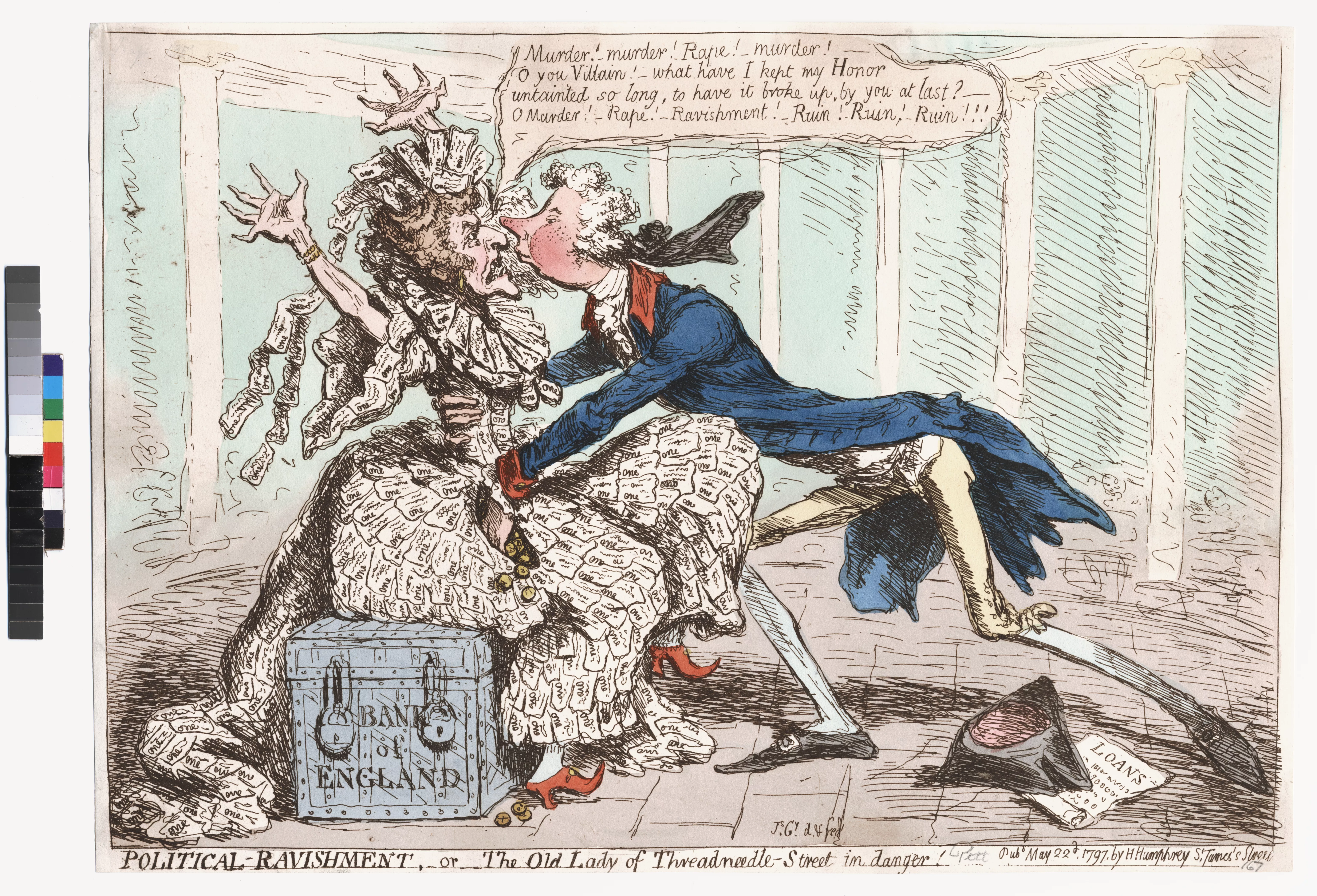Creation Date
22 May 1797
Medium
Genre
Description
Sitting atop a chest inscribed “Bank of England,” a wrinkled and thin woman dressed in paper one- pound notes throws her hands back as Prime Minister William Pitt (the Younger) reaches into her pocket with his left hand and wraps his right arm around her waste, his legs bent as he thrusts his upper body forward and his face into hers. On the cement behind him, his hat partially covers a list of loans. Pitt wears a Windsor coat and a bag-wig (protecting his clothes from the powder of the white wig). A few gold coins fall out of the pocket. The woman cries out, “Murder! Murder! Rape! Murder! O you Villain! What have I kept my honor untainted so long, to have it broken up by you at last? O Murder! Rape! Ravishment! Ruin! Ruin! Ruin!!!”
Pitt’s long, pointed nose and wiry limbs were conventional exaggerations of his figure in Gillray’s caricature. The vagina-shaped pocket is a sexually explicit visual symbol, supported by the textual references to rape and ravishment (K. Hart, James Gillray 27).
The personification of the Bank of England as “The Old Woman of Threadneedle Street” owes its origins to this print. Threadneedle Street is an actual street in London on which the Bank was located at this time. The woman's dress composed of one-pound notes identifies the contemporary political issue at hand, here related as a "rape": the suspension of payments in gold and the introduction of paper currency, meant to compensate for the reduced specie.
As a piece of political satire, Political Ravishment, or, The Old Lady of Threadneedle Street in Danger! brought viewers’ attention to recent political movements, in this case both national and personal affiars involving Prime Minister William Pitt. At this point, Gillray’s services were not purchased by the Tory government, but his clever layering of antitheses and ironies generally defy a unidirectional political critique and a resultant “propaganda” status.
The alarm incited by a French landing at Pembrokeshire on February 25, 1797, representative and affirmative of more general concerns about French invasion, necessitated an immediate cabinet meeting. With the threat a gold drain on the Bank of England, an Order of Council that met the next day decreed a suspension of payments in coin. Parliament confirmed the move on May 3. The decision allowed the Bank of England to issue paper currency without limit. Almost two weeks after the confirmation in Parliament, opponents in both the House of Lords and the House of Commons suggested that foreign loans, advances on treasury bills, and bills of exchange from abroad had necessitated the suspension; the general Whig view believed Britain’s funds wasted on foreign wars. More informal criticism compared the paper currency to the French assignats, unsound notes that the revolutionaries issued on the security of land. On March 30, Sheridan joked that the Bank was “an old woman courted by Mr. Pitt,” referring to Pitt’s recently ended courtship of the relatively older Eleanor Eden. Both the Morning Post and the Morning Chronicle relayed Sheridan’s joke, and Gillray is normally credited with coining the term “Old Lady of Threadneedle Street" (D. Hill, Fashionable Contrasts).
This print marks an important moment for British politics and its social implications for all classes. The introduction of paper currency and the doubts it raised about the power of the specie and the national bank forced a comparison to the French revolutionaries, which was especially unwelcome and uncomfortable for a culture dedicated to national order (a dedication which was seen explicitly contrary to French culture).
The subjugation of the Bank to Pitt’s political prerogatives conveyed in terms of sexual dominance is also a significant view into romantic culture: the vulnerability of the Bank of England reflects the vulnerability and lack of independence of British women, compounded in economic, political, and sexual dimensions. Despite this legal political subordination, however, women were expected to foment social order from their circumscribed position within the domestic sphere. Note how the woman representative of a national institution is depicted by this print: both horribly ugly and comparatively weak to the prime minister. In this sense, Gillray conveys the problems in the paradoxical expectations of women at the turn of the nineteenth century.
Locations Description
The Bank of England is the national bank of the United Kingdom. It was founded in 1694 during the reign of William and Mary and moved to its current location (though it has necessarily expanded) on Threadneedle Street in 1734. In its first two centuries of its existence, the Bank had commercial operations but eventually established itself as the central bank to the government and the ultimate reserve for the growing network of commercial banks. The bank was not nationalized until 1946, but has always acted out of strictly national interest.
Publisher
Hannah Humphrey
Accession Number
797.5.22.1
Additional Information
Bibliography
George, M. Dorothy. Catalogue of political and personal satires preserved in the Dept. of Prints and Drawings in the British Museum, vol. 7. London: British Museum Dept. of Prints and Drawings, 1870-1954.
Hart, Katherine W. James Gillray: Prints by the Eighteenth Master of Caricature. Hanover: Hood Museum of Art, Dartmouth College, 2004.
Derry, John W. Politics in the Age of Fox, Pitt and Liverpool: Continuation and Transformation. New York: St Martin’s Press, 1990.
Ehrman, J.P. W., and Smith, Anthony. “Pitt, William.” Oxford Dictionary of National Biography. 2004-2009. Oxford University Press. 29 March 2009 .
England. “History.” Bank of England. 29 March 2009 .
Hill, Draper. Fashionable Contrasts: Caricatures by James Gillray. London: Phaidon Press, 1966.

